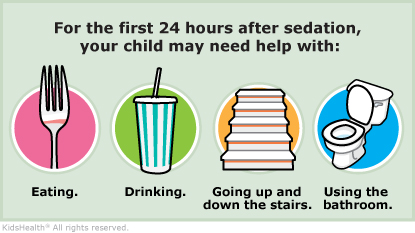Your child had sedation for a procedure. The medicines used for sedation make kids sleepy and relaxed so they can have a procedure without pain.
Your child was checked often after the procedure and is now ready to go home. Many kids feel fully awake and back to normal within a few hours of the procedure. But some kids can feel tired or cranky, have a headache, or vomit for up to 24 hours after.
Here's how to care for your child as they recover from the sedation.



Your child:

Your child:

What are the types of sedation? The main types of sedation are:
What are the risks of sedation? For most people, sedation is very safe. Rarely, someone can have an allergic reaction, breathing problems, or abnormal heart rhythms shortly after the medicine is given. Your health care provider would have told you if your child had any problems during the procedure. Some kids might get dehydrated if they vomit a lot after sedation, but this isn't common.
Researchers are studying whether sedation or anesthesia can affect the brain development of young children. Most likely, getting sedation or anesthesia for a short time for one surgery or procedure does not put a young child at risk.